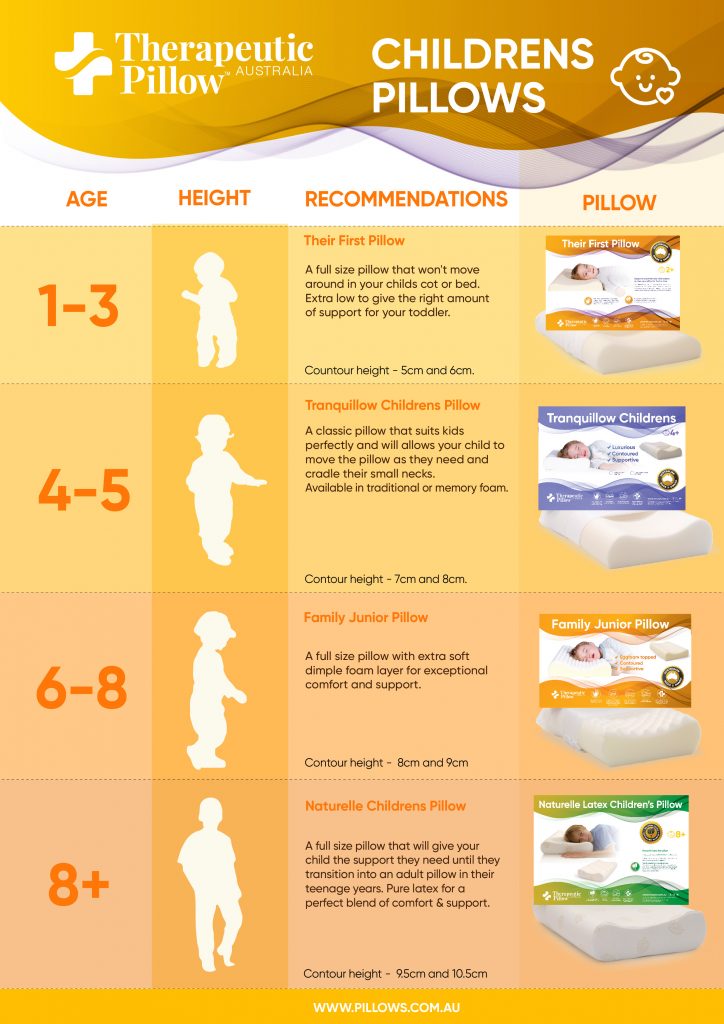When is it safe for a toddler to sleep with a pillow? Generally, pediatricians and safe sleep experts recommend introducing a pillow to a toddler’s sleep environment around 18 months to 2 years of age. However, age alone isn’t the only factor; a toddler’s developmental readiness is also crucial.

Image Source: pillows.com.au
Fathoming the Right Time for a Toddler Pillow
The transition from crib to toddler bed often coincides with parents wondering about pillows. While a soft, fluffy pillow might seem cozy, it’s vital to understand the risks associated with introducing them too early. The recommended age for toddler pillow use is a guideline, not a strict rule. Here’s what to consider.
Age Considerations
- Under 12 Months: Pillows are a definite no-no for babies under one year old due to the risk of SIDS (Sudden Infant Death Syndrome) and suffocation.
- 12-18 Months: Still generally not recommended. Focus on a safe sleep environment with a firm mattress and fitted sheet.
- 18 Months – 2 Years: The best time to introduce pillow to toddler is often within this range, if the child demonstrates certain developmental milestones.
- 2 Years and Older: If a child hasn’t shown interest or need for a pillow by this point, it’s usually safe to introduce one.
Developmental Milestones for Pillow Use
More important than age is the child’s physical and cognitive development. Look for these signs:
- Moving Freely: The toddler can easily roll over in both directions. This reduces the risk of getting stuck face-down on the pillow.
- Head and Neck Control: The child has good head and neck control. They can lift their head easily.
- Showing Interest: The toddler might try to use blankets, stuffed animals, or other objects as a pillow.
- Communicating Needs: The child can communicate discomfort or reposition themselves if they are uncomfortable.
Why Wait? Pillow Safety for Toddlers
The primary concern with pillows for very young children is pillow safety for toddlers. Here’s why delaying pillow introduction is important:
- Suffocation Risk: Infants and young toddlers lack the motor skills and strength to move away from a pillow if it obstructs their breathing.
- SIDS Risk: Although the risk of SIDS decreases after 6 months, it’s still a concern until the baby’s first birthday. Introducing a pillow before then increases that risk.
- Overheating: Thick pillows can trap heat, increasing the risk of overheating, which is another SIDS risk factor.
Toddler Pillow Introduction Guidelines
Once you’ve determined that your toddler is ready for a pillow, follow these toddler pillow introduction guidelines for a safe and successful transition:
-
Choose the Right Pillow: Select a pillow specifically designed for toddlers. It should be:
- Small: A smaller pillow is less likely to cover the baby’s face completely.
- Firm: A firm pillow provides support without posing a suffocation risk. It should not easily compress.
- Thin: A very thin pillow won’t elevate the head too much, preventing neck strain.
- Hypoallergenic: Choose a hypoallergenic material to minimize allergy risks.
- Washable: Easy cleaning is essential for hygiene.
2. Introduce it Gradually: Don’t force it. Leave the pillow in the toddler’s bed during playtime. Let them become familiar with it.
3. Observe Your Child: Watch how your child interacts with the pillow during sleep. Ensure they can still move freely.
4. Supervise Naps: Initially, only allow the pillow during supervised naps. This allows you to monitor your child’s comfort and safety.
5. Maintain Safe Sleep Practices: Continue to follow safe sleep practices, such as placing your child on their back to sleep.
6. Re-evaluate Regularly: As your child grows, reassess the pillow’s suitability. You may need to upgrade to a larger, more supportive pillow as they get older.
Selecting the Right Pillow: Size, Firmness, and Materials
The pillow size and firmness for toddlers is essential for safety and comfort.
- Size: Aim for a pillow that’s around 13×18 inches. This is small enough to prevent it from covering the entire face.
- Firmness: The pillow should be firm enough to maintain its shape but not so hard that it’s uncomfortable. Test it by pressing down on it. It should spring back quickly.
-
Materials:
- Hypoallergenic Fillings: Look for fillings like down alternative, polyester fiberfill, or memory foam specifically designed for toddlers.
- Breathable Cover: Choose a pillowcase made of breathable materials like cotton or bamboo. This helps regulate temperature and prevent overheating.
- Avoid: Pillows filled with beads, beans, or other small parts. These pose a choking hazard.
Alternatives to Pillows
If you’re hesitant about introducing a pillow, or your toddler doesn’t seem to need one, consider these alternatives:
- Folded Blanket: A thin, folded blanket can provide a slight elevation without the risks associated with a pillow. Ensure it’s securely tucked in so it doesn’t become a loose object.
- Small, Soft Toy: Some toddlers find comfort in cuddling a small, soft toy.
Potential Risks of Pillows for Young Children
It’s important to acknowledge the risks of pillows for young children. While generally safe when introduced at the appropriate age and with proper precautions, pillows can pose dangers if used incorrectly:
- Suffocation: As mentioned earlier, this is the primary concern. A soft, fluffy pillow can conform to a child’s face, making breathing difficult.
- Strangulation: Loose pillowcases or decorative elements can pose a strangulation risk.
- Allergies: Some materials can trigger allergies, leading to respiratory problems.
- Neck Strain: A pillow that’s too thick or firm can cause neck pain and stiffness.
- Dust Mites: Pillows can harbor dust mites, which can exacerbate allergies and asthma. Regular washing and using allergen-resistant covers can help mitigate this risk.
Table: Pillow Safety Checklist
| Feature | Recommendation |
|---|---|
| Age | 18 months – 2 years (minimum), based on developmental readiness |
| Size | Small (approximately 13×18 inches) |
| Firmness | Firm but comfortable |
| Material | Hypoallergenic, breathable |
| Cleanliness | Washable, with allergen-resistant cover |
| Introduction | Gradual, supervised |
| Sleeping Position | Back sleeping recommended |
Supporting Safe Sleeping Practices for Toddlers with Pillows
Even after introducing a pillow, it’s vital to maintain safe sleeping practices for toddlers with pillows:
- Back Sleeping: Continue to place your child on their back to sleep, even with a pillow.
- Clear Sleep Environment: Keep the crib or bed free of other loose objects, such as blankets, toys, and bumpers.
- Proper Bedding: Use a fitted sheet that fits snugly on the mattress.
- Room Temperature: Maintain a comfortable room temperature to prevent overheating.
- Regular Monitoring: Check on your child regularly, especially in the initial stages of pillow use.
Addressing Common Concerns About Toddler Pillows
Parents often have questions and concerns about introducing pillows. Here are some common scenarios and how to approach them:
-
“My toddler is constantly using my pillow. Does that mean they’re ready?”
It could be a sign, but it’s essential to assess their developmental readiness based on the other milestones mentioned earlier. Don’t simply give them a pillow because they seem interested.
-
“My toddler refuses to use a pillow.”
That’s perfectly fine. Some children don’t need or want a pillow. Don’t force it. They may be comfortable without one.
-
“What if my toddler rolls off the pillow during the night?”
This is normal. As long as they can roll freely, it’s not a cause for concern.
-
“How often should I wash the pillow?”
Wash the pillow every 2-3 months, or more frequently if needed. Always follow the manufacturer’s instructions. Wash the pillowcase weekly.
The Importance of Parental Instinct
Ultimately, the decision of when is it safe for a toddler to sleep with a pillow rests with the parents or caregivers. Trust your instincts and consider your child’s individual needs and development. If you have any concerns, consult with your pediatrician. They can provide personalized advice based on your child’s specific circumstances.
FAQ: Frequently Asked Questions About Toddler Pillows
-
Q: What is the recommended age to introduce a pillow to my toddler?
- A: Generally, pediatricians recommend introducing a pillow around 18 months to 2 years of age, based on developmental readiness.
-
Q: Can I give my baby a pillow before they turn one?
- A: No. Pillows are not recommended for babies under one year old due to the risk of SIDS and suffocation.
-
Q: What kind of pillow is best for a toddler?
- A: Choose a small, firm, thin, and hypoallergenic pillow specifically designed for toddlers.
-
Q: How do I know if my toddler is ready for a pillow?
- A: Look for signs such as the ability to roll over easily, good head and neck control, and showing interest in using pillows or blankets as headrests.
-
Q: What are the risks of giving my toddler a pillow too early?
- A: The main risks are suffocation, SIDS, and overheating.
-
Q: How often should I wash my toddler’s pillow?
- A: Wash the pillow every 2-3 months, and the pillowcase weekly.
-
Q: My toddler doesn’t seem to like their pillow. Should I force them to use it?
- A: No. If your toddler doesn’t like the pillow, don’t force them to use it. Some children are more comfortable without one.
-
Q: What if my toddler has allergies?
- A: Choose a hypoallergenic pillow and pillowcase to minimize allergy risks.
By carefully considering these factors and following these guidelines, you can make an informed decision about when to introduce a pillow to your toddler and ensure a safe and comfortable sleep environment.

Clark Lubowitz is a parenting expert with over 10 years of experience in toddler care and child development. Holding a degree in Early Childhood Education, he specializes in blending modern technology with parenting, offering expert advice on the best toddler gadgets. Through his work on ToddlerAwesome.com, Clark provides valuable insights to help parents make informed decisions for their little ones.
